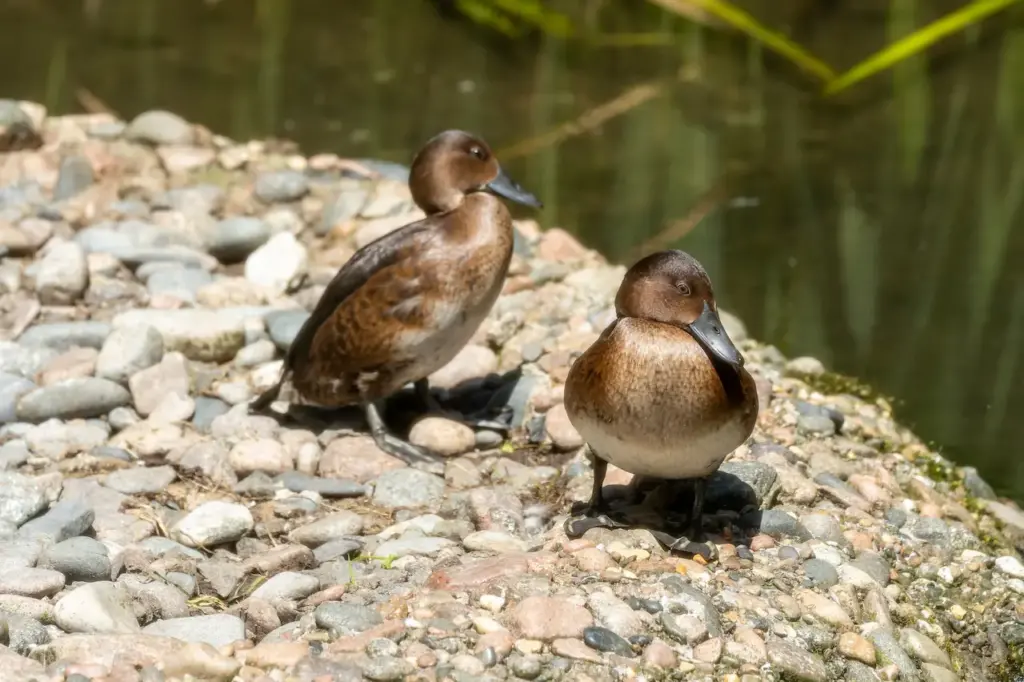Madagascar Pochard

Scientific Name
Aythya innotata
Alternative Names
Fotsy maso or Onjo (in Malagasy)
Measurements
| Measurement | Range |
|---|---|
| Body Length | 42–56 cm |
| Wingspan | ~70–80 cm (estimated) |
| Weight | Approximately 600–800 g |
| Clutch Size | 6–10 eggs |
| Diving Time (Adult) | ~24 seconds |
| Diving Time (Ducklings) | ~10 seconds from 14 days old |
Status
Critically Endangered. Thought to be extinct in the late 1990s, the species was rediscovered in 2006 at Lake Matsaborimena in northern Madagascar. Captive breeding efforts have since increased the global population to over 90 individuals as of 2017, with reintroductions beginning in 2018 at Lake Sofia. Fewer than 30 birds are estimated to survive in the wild today.
Identification
A medium-sized diving duck, adults measure between 42 and 56 cm. Breeding males have dark chestnut heads, necks, chests, and upperparts, with dark brown wings and a white wing bar. The underparts fade to white from the belly to the tail. The iris of adult males becomes white in their first winter, while females and juveniles retain brown eyes. Females are duller overall with softer chestnut-brown tones. Legs and bills are dark grey to black.
Voice
Vocalisations include a cat-like “wee-oow” and a rolling “rrr” by males during display. Females produce a harsh squawk when alarmed or disturbed.
Diet
Unlike most diving ducks, the Madagascar Pochard feeds predominantly on aquatic insects. Faecal studies indicate caddisflies, dragonfly larvae, bugs, and chironomid flies form the bulk of the diet, with minimal plant material. Adults spend approximately 38% of their day feeding. Ducklings feed at the surface until they can begin diving at around 14 days old.
Distribution
Endemic to Madagascar. Currently known only from two small volcanic lakes in the far north: Lake Matsaborimena and Lake Sofia. Historically widespread around Lake Alaotra and other shallow marshes in central Madagascar.
Habitat
Historically favoured shallow lakes and marshes with dense aquatic vegetation. The rediscovered population inhabited deep, cold volcanic crater lakes with limited plant life, likely due to the loss of original habitats to rice farming, invasive fish, and wetland degradation.
Breeding
Breeding has been observed from July to February. Nests are built 20–40 cm above water on emergent vegetation, often among sedges (Cyperaceae). Clutches contain 6 to 10 eggs. Multiple nesting attempts in one season are possible. Ducklings are led to water soon after hatching.
Wintering
This species is non-migratory and remains within its breeding range year-round. It typically does not form flocks and is seen alone or in pairs.
Conservation
Causes of decline include invasive fish species that predated chicks and destroyed nests, rice cultivation, shoreline burning, grazing, gill-net fishing, introduced mammals, and hunting. Rediscovered in 2006, conservation is led by the Durrell Wildlife Conservation Trust, Wildfowl and Wetlands Trust, and local partners. Captive breeding began successfully in 2009. In December 2018, 21 individuals were released into Lake Sofia, supported by floating aviaries and community-led wetland management. Continued conservation efforts focus on habitat restoration, population monitoring, and sustainable human-wildlife coexistence.
